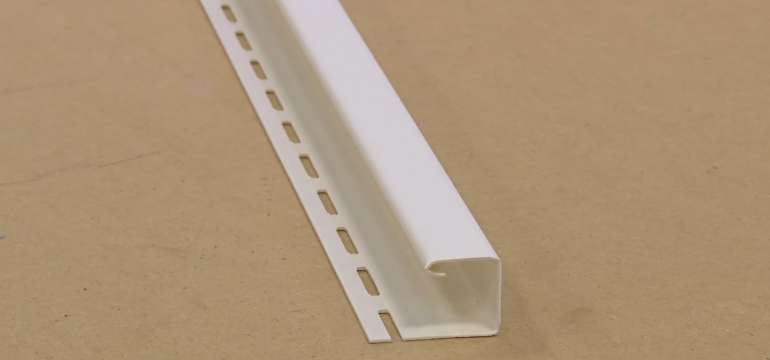If you’re working on the eaves and edges of your home, you’re probably getting excited because your work is nearly done! You’ve just got the exterior trim left to do, and then the siding and eaves will look smooth and seamless.
One thing you’ll need to determine is whether to use the F channel or the J channel for soffit. Explore the uses of each type of channel and their potential usefulness for the soffit area of your home’s roof.
Parts of Your Eaves and Roof Overhang
First of all, let’s solidify the definitions of some essential parts of the roof and siding. Knowing these terms will help you visualize how the F channel or J channel for soffit fits in with the exterior design of your home.

Soffit: Any roof that overhangs the edge of the home’s wall or siding should always have soffit. It’s a protective material that fits between the wall and the eaves. Basically, it covers the underside of the overhang, both for a better aesthetic and for defense against moisture, pests, and other damaging influences. Often, the soffit resembles the home’s siding in texture and color.
Fascia: The fascia runs along the eaves. It’s a type of trim that gives the edge of the roof a cleaner look. It also protects the underlying wooden structure, as well. While the soffit covers the underside of the overhang, the fascia covers the outer face of the eaves.
Features of J Channel Siding

J channel is also a kind of narrow trim used for siding. Typically a piece of J channel is long, with crisp corners and a groove wide enough to accommodate the width of a piece of siding. There are also open slots along one top edge of the J channel trim, where nails can be placed to secure the piece.
J channel is often used for corners and edges, and around openings like windows and doors. Not only does the J channel seal off the siding, but it also helps hold the pieces of siding together. The siding is inserted into the folded J channel. Without J channel trim in place, the siding would look messy and slipshod. When it’s correctly installed, J channel gives the exterior of your home a crisp, clean look.
Features of F Channel Siding

F channel siding is shaped differently than the J channel. When you look at a piece of it from the end, you’ll notice that its form is very similar to the letter F. The central branch of the F is a pinched or folded section of the metal. Along the bottom are slots for the nails used to affix the piece to the house.
F Channel vs. J Channel for Soffit
F channel is usually attached to beams or studs of the house, along the underside of the roof overhang. It provides a sort of shelf where the ends of the soffit pieces rest. Basically, it’s essential for installing the soffit.
J channel, on the other hand, is intended for closing off the ends or edges of siding, and for creating a more seamless look around doors and windows. However, some contractors also employ it for soffit. You’ll need extra pieces of the channel if you plan to use the J channel style for soffit installation.
Typically, builders prefer F channel for soffit, since it’s designed for the purpose. Because it’s crafted to suit the soffit, it doesn’t take as long to install. If you choose J channel, you’ll have to install twice as many pieces, both to hold up the soffit and to cover the edges.
Installing F Channel for Soffit
When you’re installing F channel for soffit, you need to affix the pieces to the beams on the underside of the overhang. Place the F channel pieces across from each other, with the right amount of space between them for the panels of the soffit to slide between them and fit securely.
Installing J Channel for Soffit
J channel pieces should be installed similarly to the F channel—across from each other, so the soffit fits between the lengths of the J channel. You can use roofing nails that are made of galvanized aluminum or stainless steel with high user ratings and good resistance to corrosion. Remember to caulk wherever you’re using J channel, especially if you’re applying it around doors, windows, conduits, and utility outlets.
Whether you’re installing F channel or J channel for soffit, keep in mind that your soffit panels and other parts of your roof need some space and flexibility. They need room to expand and contract during the dramatic temperature changes of the seasons.
Always insert the nails in the slots that are integrated into each piece of F channel or J channel, rather than trying to make your own nail holes. Also, make sure you secure the nails without driving them too tight; that way, they’ll have a little room to shift as they need to.
- How to Cut Lexan - September 25, 2020
- Mineral Spirits vs. Mineral Oil - September 25, 2020
- Shellac vs. Polyurethane - September 24, 2020

Denise
Thursday 4th of November 2021
Can I put vinyl soffit over the plywood that is already there?
Brandon
Saturday 26th of April 2025
@Denise, Yes that is exactly its purpose. You never want to leave wood exposed to the elements if possible. In your case it sounds like your overhang is already covered by plywood sheeting. When this is the case and the beams are no longer exposed then "J" channel will most likely be the best choice. As "F" channel would be required to attach to the inside of the beam.